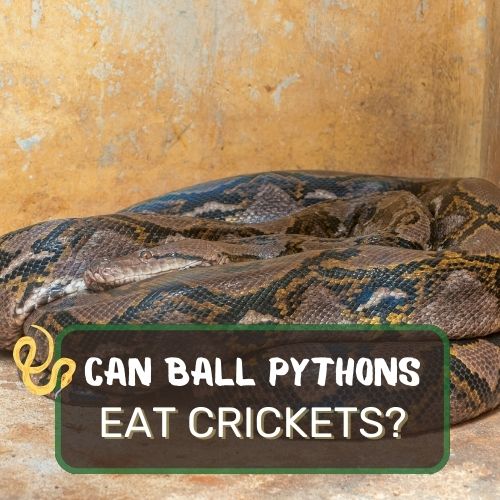
As these captivating creatures slither their way into our hearts, understanding their dietary needs becomes paramount.
In this article, we’ll unravel the mystery behind this intriguing question.
Delving deep into the natural dietary habits of ball pythons, we’ll explore the pros and cons of introducing crickets into their diet.
By examining factors like nutritional value, potential health risks, and the python’s natural preferences, we aim to provide a comprehensive answer.
So, if you’re eager to ensure the best dietary choices for your slithery companion, read on! This article promises insights backed by research and expert opinions.
Table of Contents
Can Ball Pythons Eat Crickets? (Short Answer)
Ball pythons, native to West and Central Africa, primarily consume small mammals like rodents in the wild. While they can eat crickets, these insects aren’t a staple in their natural diet and might not provide the necessary nutrients for a growing python. Offering crickets occasionally as a treat or supplement might be acceptable, but they shouldn’t replace the primary diet of appropriately-sized rodents.
If considering crickets or any new food source, always monitor your python’s reaction and consult with a reptile specialist to ensure the health and well-being of your pet.

Ball Python Dietary Basics
Ah, the ball python! One of the most popular pet snakes in the world, and for good reason. They’re relatively easy to care for, have a calm demeanor, and can be absolutely captivating to watch. But, like all pets, they have specific dietary needs.
Let’s dive into the world of ball python nutrition and answer the burning question: Can ball pythons eat crickets?
Natural Diet in the Wild
In the vast grasslands and forests of West and Central Africa, where ball pythons call home, their diet is primarily composed of small mammals.
Imagine a ball python stealthily slithering through the underbrush, its heat-sensitive pits detecting the faintest warmth of a nearby rodent. With a swift strike, the python secures its meal.
It’s a dance as old as time, and rodents like gerbils, shrews, and African soft-furred rats are the main course.
Now, you might be thinking, “But what about insects like crickets?” In the wild, it’s quite rare for a ball python to munch on a cricket.
Their dietary preferences lean heavily towards meatier prey that provides the essential nutrients they need for growth and health.
Common Prey Items for Ball Pythons
In captivity, the menu for ball pythons is a bit more streamlined. The majority of ball python owners feed their slithery friends rodents, primarily because they’re nutritionally complete. Mice and rats, either live or frozen-thawed, are the go-to choices.
These rodents offer the right balance of protein, fat, and other essential nutrients.
But here’s where the crickets come into play. Some adventurous snake owners might wonder if crickets, a common food for many reptiles, could be a tasty treat for their python.
While crickets are packed with protein and can be a good food source for many reptiles, they’re more of an appetizer for ball pythons rather than a main course.
Remember, these snakes have evolved to eat meaty prey, and a cricket might not satiate their hunger or provide all the nutrients they need.
Importance of a Varied Diet
Variety is the spice of life, and it’s no different for ball pythons. While rodents should be the primary food source, introducing occasional variety can be beneficial. Think of it as giving your snake a little treat.
However, always ensure that any new food, be it crickets or something else, is safe and suitable for your python.
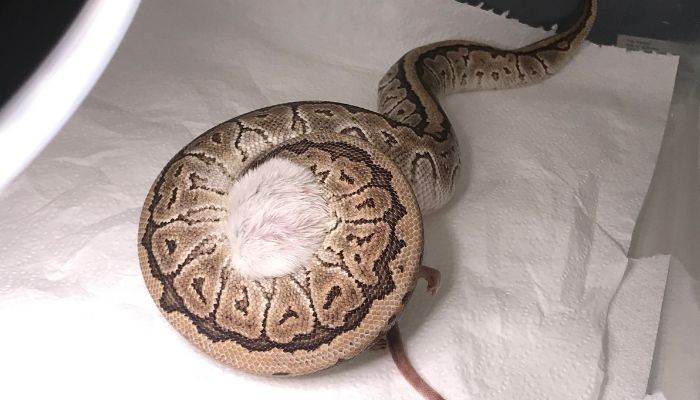
Pros of Feeding Crickets to Ball Pythons
Feeding crickets to ball pythons? It might sound a tad unconventional, especially when you consider the meaty appetite of these fascinating creatures.
But, believe it or not, there are some potential benefits to occasionally introducing crickets into your python’s diet. Let’s delve into the pros of this crunchy proposition.
Easy Availability and Affordability
Walk into any pet store, and you’re bound to find a section dedicated to live crickets. They’re a staple food for many reptiles, amphibians, and even some birds.
This widespread demand means they’re readily available and, more often than not, quite affordable.
For ball python owners on a budget or those living in areas where other food sources might be scarce, crickets can be a convenient option.
Plus, with the rise of online retailers specializing in reptile care, you can even have crickets delivered right to your doorstep!
Potential for Variety in the Diet
Imagine eating the same meal day in and day out. Sounds boring, right? While ball pythons don’t necessarily crave variety like we do, introducing different food sources can be beneficial.
Crickets, being a different texture and taste, can pique your python’s interest. It’s like offering a new culinary experience to your slithery friend. And as we all know, a little variety can go a long way in ensuring overall well-being.
Crickets as a Source of Hydration
Here’s a fun fact: crickets contain water. Yes, these tiny critters can be a source of hydration for your ball python.
While snakes get most of their hydration needs from their regular water bowls, the moisture content in crickets can provide an added boost, especially in drier environments. It’s like your python getting a meal and a drink, all in one!
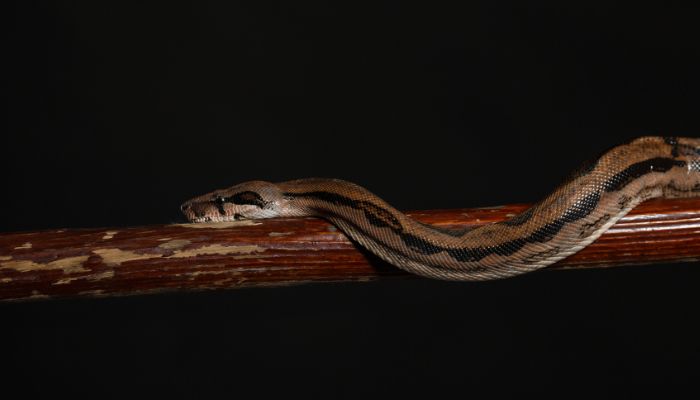
The Risks of Feeding Crickets to Ball Pythons
While there are some potential benefits to feeding crickets to ball pythons, it’s essential to approach this dietary choice with caution.
Like all things in life, there’s a flip side to the coin. Let’s dive deep into the potential risks associated with feeding crickets to these majestic creatures.
Potential Health Risks
First and foremost, ball pythons have evolved over millennia to consume meaty prey, primarily rodents. Their digestive systems are fine-tuned to extract nutrients from such prey.
Crickets, while nutritious for many reptiles, might not offer the complete dietary profile a ball python needs. Over-reliance on crickets could lead to nutritional deficiencies, impacting the snake’s health over time.
For instance, crickets might not provide the right balance of calcium and phosphorus that pythons require, potentially leading to bone health issues.
Size and Chitinous Exoskeleton: A Digestive Challenge
Crickets come with a hard, chitinous exoskeleton. While this exoskeleton is a walk in the park for many reptiles to digest, it can pose challenges for ball pythons. The size of the cricket also matters.
Juvenile crickets might be easier to digest, but adult crickets with their fully developed exoskeleton can be a tough meal to process.
There’s a risk of the exoskeleton causing impactions or blockages in the python’s digestive tract. And trust me, a digestive blockage is the last thing you’d want for your beloved pet.
Potential Toxins and Parasites: A Hidden Threat
Here’s something that might give you the heebie-jeebies. Crickets, especially those caught in the wild or from unreliable sources, might carry parasites or toxins. These parasites can transfer to your ball python, leading to a host of health issues.
Additionally, crickets might have been exposed to pesticides or other chemicals, which can be harmful to pythons when ingested. Always source crickets from reputable suppliers to minimize this risk.
Furthermore, some crickets feed on toxic plants. When a ball python consumes such a cricket, it indirectly ingests these toxins, which can lead to poisoning or other adverse reactions.
It’s a classic case of “you are what you eat,” and in this scenario, the cricket’s diet can have direct implications on your python’s health.
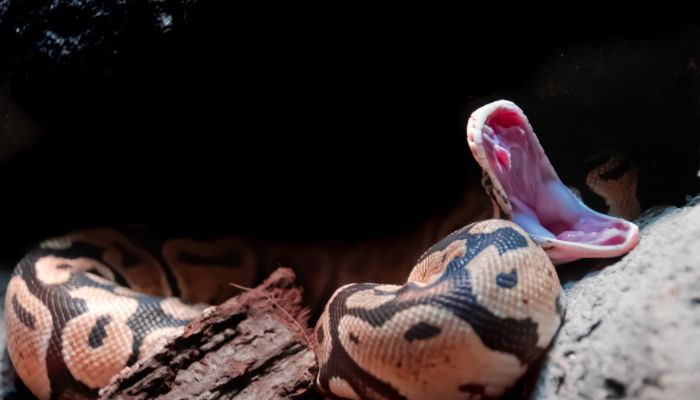
Alternative Prey Items for Ball Pythons
Ah, the diverse world of ball python cuisine! While we’ve delved into the pros and cons of feeding crickets to these magnificent creatures, it’s essential to understand the broader spectrum of their dietary choices.
After all, variety is the spice of life, even for our slithery friends. Let’s explore the alternative prey items suitable for ball pythons.
Mice and Rats: The Staple Diet
When it comes to ball python dining, mice and rats reign supreme. These rodents are the bread and butter (or should I say meat and potatoes?) of a ball python’s diet.
Whether live or frozen-thawed, mice and rats provide a nutritionally complete meal. They offer the right balance of protein, fats, and other essential nutrients that pythons need to thrive.
Plus, their size and meaty composition align perfectly with the python’s natural predatory instincts and digestive capabilities.
Other Insects and Their Benefits
While crickets have their place, other insects can also be considered as occasional treats for ball pythons. Think mealworms, waxworms, or even roaches.
These insects, especially when gut-loaded (fed a nutritious diet before being offered to the python), can provide additional nutrients. For instance, mealworms are rich in protein, while waxworms offer a fatty treat.
However, like crickets, these should be supplementary and not replace the primary diet of rodents.
Importance of Size and Age-Appropriate Feeding
One size doesn’t fit all, especially when feeding ball pythons. A hatchling python has different dietary needs compared to a full-grown adult. It’s crucial to offer prey items that are appropriate for the python’s size and age.
Overfeeding or offering prey that’s too large can lead to digestive issues or even injury. As a general rule of thumb, the prey’s width should not exceed the widest part of the python’s body.
And as your python grows, you can gradually introduce larger prey items, ensuring they get the nutrition they need at every stage of their life.
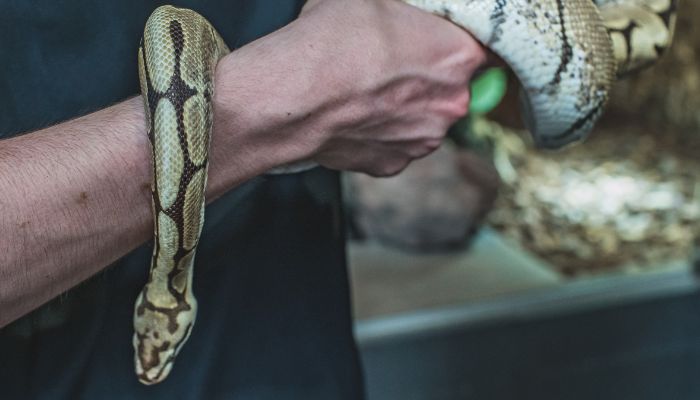
Safety Precautions When Introducing New Food
Introducing a new food item to your ball python’s diet can be akin to venturing into uncharted territory. While the idea of offering something new might be exciting, it’s crucial to tread with caution.
After all, the well-being of your slithery companion is paramount. Let’s dive into the safety precautions you should consider when embarking on this culinary adventure.
Importance of Monitoring Your Python’s Reaction
Just like humans, every ball python is unique. What might be a hit with one python could be a miss with another. When offering a new food item, like crickets, it’s essential to keep a close eye on your python’s reaction.
Are they showing interest? Do they seem hesitant? Observing their behavior can provide valuable insights into their preferences and any potential issues.
Signs of Digestive Distress or Disinterest
Ball pythons have their way of communicating, and it’s up to us to understand their signals. If your python regurgitates the food or has difficulty swallowing, it could indicate digestive distress.
On the other hand, if they simply ignore the new food or seem disinterested, it might not be to their liking. Always be on the lookout for changes in their behavior, stool consistency, or overall health after introducing a new food item.
Tips for Safely Introducing Crickets or Any New Food
- Source Quality: Always source crickets or any new food from reputable suppliers to ensure they’re free from toxins or parasites.
- Start Small: Initially, offer a small quantity to gauge your python’s reaction.
- Gut-Load: If offering insects, ensure they’re gut-loaded, meaning they’ve been fed a nutritious diet, enhancing their nutritional value.
- Consult Experts: If in doubt, consult with a reptile specialist or veterinarian for guidance.
While variety can enrich a ball python’s diet, safety should always be the top priority. By following these precautions, you can ensure that your python enjoys a diverse, nutritious, and safe diet.
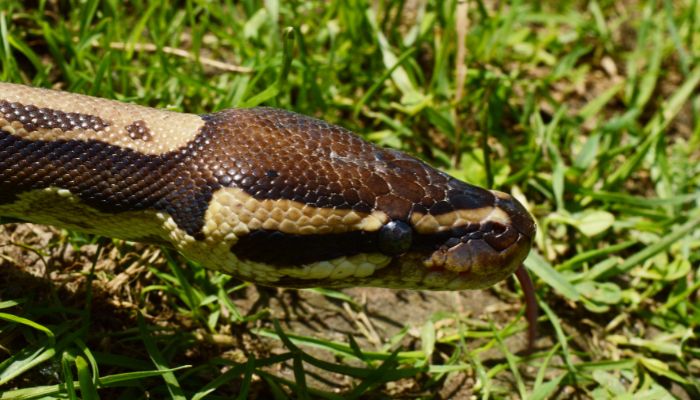
Conclusion
You’ve journeyed through the intricate world of ball python diets, exploring the central question: Can ball pythons eat crickets?
As you’ve discovered, while these reptiles primarily thrive on a diet of rodents, there’s potential for occasional variety with insects like crickets.
However, it’s essential to tread with caution, considering the nutritional needs and potential risks.
Remember, every ball python is unique, and what works for one might not work for another. It’s always about striking the right balance and ensuring the well-being of your slithery companion.
As you continue your journey in reptile care, always prioritize research and consultation with experts. Your dedication to understanding and providing the best for your pet is commendable.
In the vast realm of reptile care, there’s always something new to learn and discover. Stay curious, keep asking questions, and never hesitate to seek knowledge.
Your ball python’s health and happiness are a testament to your efforts. Keep up the fantastic work, and here’s to many joyful moments with your captivating companion!
FAQ
As these magnificent creatures continue to captivate the hearts of reptile enthusiasts, it’s only natural to have a plethora of queries. Let’s tackle some of the most frequently asked questions about ball python diets.
Can a ball python eat insects?
Yes, ball pythons can eat insects like crickets, mealworms, or waxworms. However, these should be considered as occasional treats rather than primary food sources. While insects can provide some nutrients, they don’t offer the complete dietary profile that rodents do for ball pythons.
Can ball pythons eat fish?
While some snakes do consume fish, it’s not a natural or recommended diet for ball pythons. Fish might lack certain essential nutrients and could also introduce parasites. It’s best to stick to their primary diet of rodents.
How to feed a ball python for the first time?
Start with a small, appropriately-sized rodent, preferably a mouse. Ensure the environment is calm, and place the food item in the python’s enclosure using tongs. Give the python some time and space to approach and consume the prey. Remember, patience is key!
Will a ball python eat a chicken egg?
While some snake species are known to consume eggs, it’s not typical behavior for ball pythons. They primarily prefer meaty prey. Introducing chicken eggs might not be nutritionally beneficial and could lead to digestive issues.


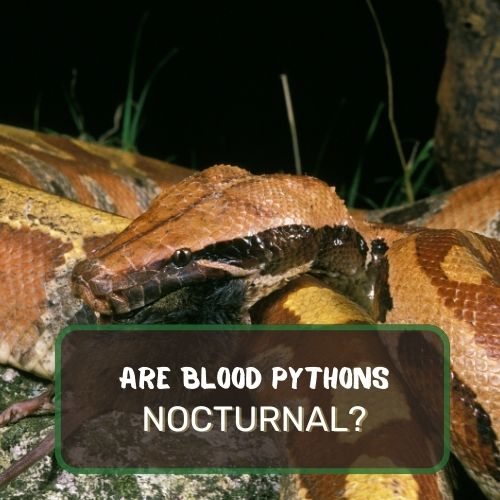

0 Comments